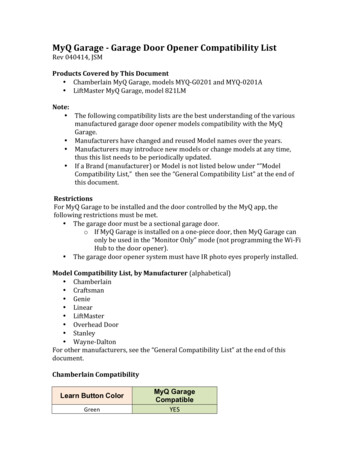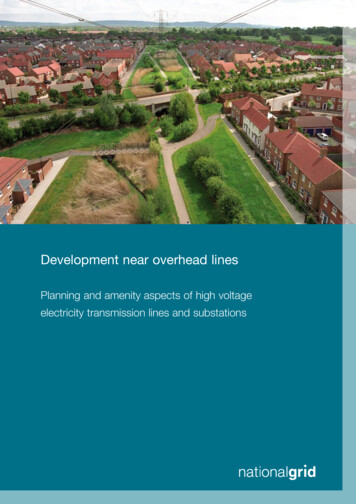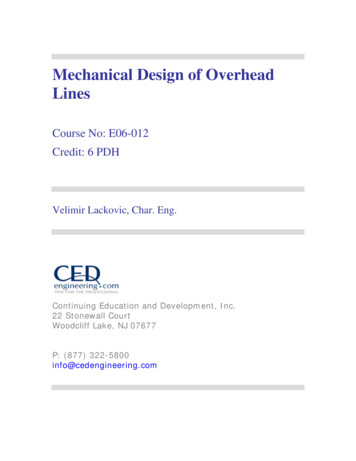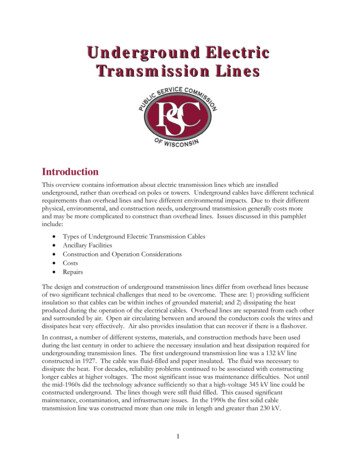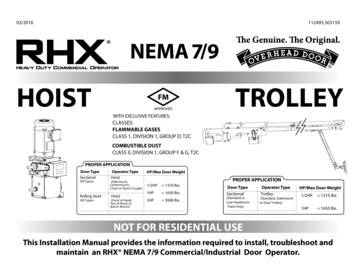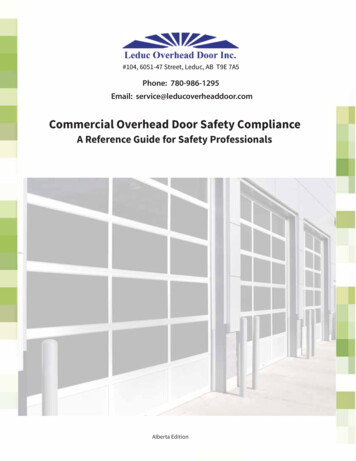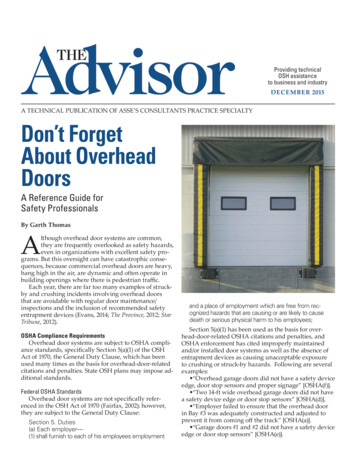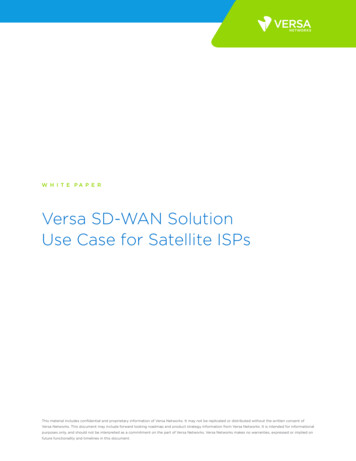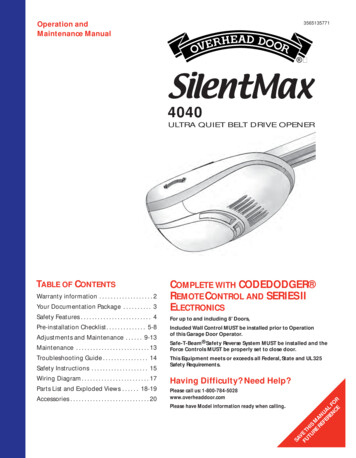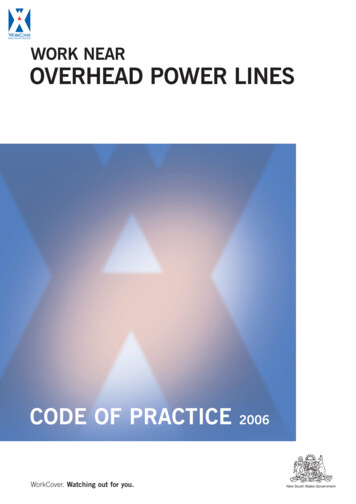
Transcription
WORK NEAROVERHEAD POWER LINESCODE OF PRACTICEWorkCover. Watching out for you.2006New South Wales Government
DisclaimerThis publication may contain occupational health and safety and workers compensation information. It may include some of your obligations under thevarious legislations that WorkCover NSW administers. To ensure you comply with your legal obligations you must refer to the appropriate legislation.Information on the latest laws can be checked by visiting the NSW legislation website (www.legislation.nsw.gov.au) or by contacting the free hotlineservice on 02 9321 3333.This publication does not represent a comprehensive statement of the law as it applies to particular problems or to individuals or as a substitute forlegal advice. You should seek independent legal advice if you need assistance on the application of the law to your situation. WorkCover NSW
CONTENTSPAGEWHAT IS AN INDUSTRY CODE OF PRACTICE?4PREFACE5WHAT IS WORK NEAR OVERHEAD POWER LINES?5PERSONNEL WORKING NEAR OVERHEAD POWER LINES5HOW CAN WORKING NEAR LIVE OVERHEAD POWER LINES BE DANGEROUS?6WHAT DO THE SYMBOLS IN THE CODE OF PRACTICE MEAN?6ACKNOWLEDGEMENT6CHAPTER 1 – ble legislation81.8Definitions9CHAPTER 2 – CONSULTATION AND RISK MANAGEMENT142.1Consultation at the workplace142.1.1Consultation arrangements152.1.2Consultation procedures152.1.3When should consultation be undertaken?152.1.4How should consultation be undertaken?162.2Risk management at the workplace162.2.1Identify hazards162.2.2Assess risks172.2.3Eliminate or control the risk172.2.4Review risk assessment and control measures182.3Information, instruction, training and supervision182.4Provision of information182.4.1192.5Safe work method statementsPreparation for work to commence19CHAPTER 3 – A PPROACH DISTANCES WHEN WORKING NEAR OVERHEADPOWER LINES203.1Scope203.2Basis of approach distances?203.2.1Assessing the relevant approach distance203.2.2Increases to approach distances223.2.3How close can I go to overhead power lines?221
3.3Ordinary Person Zone233.4Accredited Person Zone233.5Work inside the No Go Zone – Approval of the network operator253.6Approach Distances for Vehicles253.7Work near overhead power lines – General risk management principles263.8Competence and knowledge of this code273.8.1Training and Competence – Accredited Person273.8.2Maintenance of competency273.9Safety Observer – General requirements27CHAPTER 4 – O PERATING CRANES AND MOBILE PLANT NEAROVERHEAD POWER LINES294.1Scope294.2Hazard identification294.3Risk assessment304.4Control measures for cranes and mobile plant operating near overhead power inistrative controls324.5Workers in contact with the crane, load or mobile plant334.5.1Operators334.5.2Other workers344.6Competency requirements344.7Safety observer for crane and mobile plant operations344.8Earthing systems for cranes and mobile plant354.9Notices to be fixed to cranes and mobile plant35CHAPTER 5 – T REE AND VEGETATION MANAGEMENT NEAR OVERHEADPOWER LINES365.1Scope365.2Hazard identification and risk assessment365.3Eliminating or controlling risks – General risk factors365.4Requirements for Ordinary Persons carrying out tree and vegetation management375.5Requirements for Accredited Persons carrying out tree and vegetation management385.6Tree management inside the No Go Zone – Approval of the network operator385.7Trees or branches contacting live overhead power lines39CHAPTER 6 – WORK INVOLVING SCAFFOLDING NEAR OVERHEAD POWER LINES406.1Scope406.2Hazard identification406.3Risk assessment406.4Eliminating or controlling risks – general risk factors412
6.5Control measures for the erection and dismantling of scaffolding near overhead power lines416.6Erected Scaffolding – Use of a hoarding for reduced safety clearances43CHAPTER 7 – AGRICULTURAL WORK NEAR OVERHEAD POWER LINES457.1Scope457.2Hazard identification457.3Risk assessment467.4Control measures for agricultural work near overhead power lines46CHAPTER 8 – WORK NEAR LOW VOLTAGE OVERHEAD SERVICE LINES488.1Scope488.2Approach distance for work near low voltage overhead service lines488.3Work inside the relevant approach distance498.4Hazard identification498.5Risk assessment508.6Control measures for work near low voltage overhead service lines50CHAPTER 9 – A DDITIONAL CONSIDERATIONS FOR WORK NEAROVERHEAD POWER LINES529.1Tiger tails529.2Notification of incidents52APPENDIX 1 – Warning notice for overhead electrical hazards54APPENDIX 2 – Example of a risk assessment checklist55APPENDIX 3 – Example Safe Work Method Statement57APPENDIX 4 – Model Training Course Guidelines – Safe Electrical Approach Training60APPENDIX 5 – Emergency procedure following contact with overhead power lines62APPENDIX 6 – Case Studies of Overhead Power Line Incidents64APPENDIX 7 – Useful publications663
WHAT IS AN INDUSTRY CODE OF PRACTICE?An approved industry code of practice is a practical guide to employers and others who have dutiesunder the Occupational Health and Safety Act 2000 (OHS Act) and the Occupational Health and SafetyRegulation 2001 (OHS Regulation) with respect to occupational health, safety and welfare.An industry code of practice is approved by the Minister administering the OHS Act. It comes into force onthe day specified in the code or, if no day is specified, on the day it is published in the NSW GovernmentGazette. An approved industry code of practice may be amended from time to time (or it may be revoked)by publication in the Gazette.An approved industry code of practice should be observed unless an alternative course of action thatachieves the same or a better level of health, safety and welfare at work is being followed.An approved industry code of practice is intended to be used in conjunction with the requirements of theOHS Act and the OHS Regulation but does not have the same legal force. An approved industry codeof practice is advisory rather than mandatory. However, in legal proceedings under the OHS Act or OHSRegulation, failure to observe a relevant approved industry code of practice is admissible in evidence toestablish an offence under the OHS Act or OHS Regulation.A WorkCover Authority inspector can draw attention to an approved industry code of practice in animprovement or prohibition notice as a way of indicating the measures that could be taken to remedy analleged contravention or non-compliance with the OHS Act or OHS Regulation. Failure to comply with animprovement or prohibition notice without reasonable excuse is an offence.In summary an approved INDUSTRY CODE OF PRACTICE: gives practical guidance on how health, safety and welfare at work can be achieved; should be observed unless an alternative course of action that achieves the same or a better level ofhealth, safety and welfare in the workplace is being followed; can be used in support of the preventive enforcement provisions of the Occupational Health andSafety Act; can be used to support prosecutions for failing to comply with or contravening the OHS Act or OHSRegulation.4
PREFACEThe aim of this code of practice is to protect the health and safety of persons from the risks arising whenthey are working near overhead power lines and associated electrical apparatus. It provides practicaladvice on implementing the requirements of the Occupational Health and Safety Act 2000 and theOccupational Health and Safety Regulation 2001.This code of practice provides practical guidance on the risk control measures, competency requirementsand approach distances for workers working near overhead power lines. It applies to people with varyinglevels of qualification, training or knowledge.This code of practice will assist employers, self-employed persons, employees, contractors and otherparties involved in managing electrical risks associated with work near overhead power lines.Use this code of practice to assess the effectiveness of your present arrangements when working nearoverhead power lines, and to check that all risks have been identified, assessed and eliminated orcontrolled.This code of practice has been developed in consultation with members of the NSW electricity supplyindustry, including relevant unions and employer bodies. It is based on the earlier Electricity Associationof N.S.W publication, Interim Guide for Operating Cranes & Plant in Proximity to Overhead PowerLines, and the Australian Standard AS 2550.5 – 2002 Cranes, hoists and winches – Safe use Part 5:Mobile and Vehicle Loading Cranes, which was gazetted as an approved industry code of practice on21 September 2001 in the Code of Practice: Technical Guidance. In the event of any inconsistenciesbetween the Standard and this code, the code shall prevail.WHAT IS WORK NEAR OVERHEAD POWER LINES?There are legislative obligations on employers, self-employed persons and controllers of premises in regardto undertaking work in close proximity, or at an unsafe distance, to overhead power lines. The term ‘near’is utilised as a reference point for persons planning and undertaking this work.Work ‘near’ overhead power lines means a situation where there is a reasonable possibility of a person,either directly or through any conducting medium, coming closer than the approach distances specifiedin this code. For the purposes of this code the term ‘near’ can be interchanged with other legislative orcommonly used industry terms ie ‘close proximity’, ‘unsafe distance’ or ‘in the vicinity of’.PERSONNEL WORKING NEAR OVERHEAD POWER LINESThis code of practice is based on the assumption that without appropriate technical knowledge andexperience of electricity distribution networks and associated electrical apparatus, untrained personnelworking or operating cranes or plant near overhead power lines will not be able to identify the operatingvoltage concerned, and will therefore not be able to recognise and avoid the inherent dangers of liveoverhead power lines. These personnel are termed ordinary persons.The approach distances specified in this code of practice take account of differing levels of technicalknowledge, and are substantially greater for ordinary persons than for personnel who have been trainedand assessed as having the necessary technical knowledge. These personnel are termed accreditedpersons.5
HOW CAN WORKING NEAR LIVE OVERHEAD POWER LINES BE DANGEROUS?Overhead power line contact is one of the largest single causes of fatalities associated with mobile plantand equipment.Contact with live overhead power lines is a serious risk because any voltage that causes sufficient currentto pass through the heart is potentially injurious or even fatal.Contact with live electricity can also cause serious burns arising from the discharge of electrical energy.Other risks include fires and explosions that may immobilise the equipment involved.You don’t have to have a direct contact with a high voltage overhead power line to receive a fatal electricshock. Simply being too close can kill.WHAT DO THE SYMBOLS IN THE CODE OF PRACTICE MEAN?To help you work out what you require, a number of symbols are used to highlight things you need to takeinto account and tools to help you do the job.Consult and communicate with employersLegal obligations that must be followedThe process of finding things that cause harm, working out how big a problem they areand fixing them.Assess the risks in your workplaceTools that can help you work out your planACKNOWLEDGEMENTIn developing this code of practice WorkCover NSW has drawn on information contained in a number ofcodes of practice and industry guidelines issued by other State regulators or organisations. WorkCoverNSW acknowledges the following publications, which have been incorporated in parts of this code. Code of practice – Working near exposed live parts – Queensland, Department of IndustrialRelations, and Framework for undertaking work near overhead and underground assets – WorkSafe, Victoria, and NENS 04-2003 National guidelines for safe approach distances to electrical apparatus – EnergyNetworks Association.6
CHAPTER 1 – ESTABLISHMENT1.1TitleThis is the Code of Practice – Work near Overhead Power Lines.1.2PurposeThis code of practice provides practical guidance in order to protect the health and safety of personsworking near overhead power lines and associated electrical apparatus. It provides guidance on therisk control measures, competency requirements and approach distances to live electrical conductors,including no go zones for cranes and plant (and their loads), as well as for vehicles, individuals and handheld tools. It applies to persons with varying levels of qualification, training or knowledge.This code of practice should be used instead of the Interim Guide for Operating Cranes and Plant inProximity to Overhead Power Lines – ISSC 26 issued by the Electricity Association of NSW inSeptember 2001.1.3 ScopeThis code of practice applies to work, which is carried out near overhead power lines and associatedelectrical apparatus excluding: work on electricity network assets where the work is carried out in accordance with the requirementsof the Electricity Supply (Safety and Network Management) Regulation 2002 and the work is either: by or for an electricity network operator, or by an accredited service provider, or by a telecommunications network operator.mobile plant or vehicles operating on a public road where the design envelope is not greater than thetransit envelope and is in any case not greater than 4.6 metres in height (eg a side loading wastecollection vehicle collecting waste bins from the side of a public road under overhead power lines); when the crane or item of plant is correctly stowed for travelling on a public road; work on a mine site; work involving low flying aircraft (eg crop dusting, pesticide or herbicide spraying, etc); work carried out by emergency services personnel, including state emergency service, fire, police,volunteer rescue association and ambulance personnel during a declared emergency or otherlocal emergency incident. In this situation the agency should advise the network operator ofthe circumstances of the emergency work and ensure a safe system of work is applied by thoseemergency services personnel undertaking the work.This Chapter 1 is introductory, describes the purpose of this code, and provides definitions. Chapter2 explains the regulatory principles in the occupational health and safety legislation, which this codeis intended to complement. Chapter 3 describes a framework for work near overhead power lines byoutlining general risk management principles, competency requirements and approach distances for thework. More detailed risk management requirements for specific workplace activity are set out in Chapters4 to 9 inclusive.7
1.4AuthorityThis is an industry code of practice approved by the Minister for Commerce, under section 43 of theOccupational Health and Safety Act 2000, on the recommendation of the WorkCover Authority of NewSouth Wales (‘WorkCover NSW’).1.5CommencementThis code takes effect on [Gazettal /date]1.6Interpretation1.6.1Recommended practicesWords such as ‘should’ indicate recommended courses of action. ‘May’ or ‘consider’ indicate a possiblecourse of action the duty holder should consider. However, you may choose an alternative method ofachieving a safe system of work. For a further explanation, see ‘What is an industry code of practice’.1.6.2Legal obligationsWords such as ‘must’, ‘requires’ and ‘mandatory’ indicate obligations, which must be complied with.Failure to comply with the code can be used as evidence in proceedings for an offence against the OHSAct or OHS Regulation (where the code is relevant to any matter, which it is necessary for the prosecutionto prove to establish the commission of the offence).1.7Applicable legislationConsult the OHS Act and the OHS Regulation for the specific legal requirementsregarding occupational, health and safety responsibilities for work near overheadpower lines.Specific responsibilities:Clause 41(4) of the OHS Regulation requires a controller of premises to ensure that persons working in,or undertaking maintenance on, the premises (apart from those undertaking electrical work) are preventedfrom coming within an unsafe distance from any overhead power lines or live electrical installations unlessa risk assessment determines otherwise.Clause 64(2)(e) of the OHS Regulation requires employers to ensure that persons at work, their plant,tools or other equipment and any materials used in or arising from the work do not come into closeproximity with overhead electrical power lines (except if the work is done in accordance with a written riskassessment and safe system of work and the requirements of the relevant electricity supply authority).Other significant legislation:The Electricity Supply (Safety and Network Management) Regulation 2002, which is administered bythe Department of Energy, Utilities and Sustainability, requires that a person must not carry out work onor near a network operator’s transmission or distribution system and a network operator must not allow aperson to carry out work on or near its transmission or distribution system unless the person is qualifiedunder the relevant requirements of the network operator’s network management plan, to carry out thework; and the work is carried out in accordance with the relevant requirements of that plan.8
1.8DefinitionsThe following definitions are used for the purposes of this code of practice:access authoritymeans a written authorisation, issued by a network operator, which allowspersons to work within the no-go zone.accredited personmeans a person who has successfully completed a recognised training courserelating to work near overhead power lines that has been conducted by aregistered training organisation.accredited service provider means a person who has been accredited by the Department of Energy,Utilities and Sustainability to undertake work on the electricity network.approach distancemeans the minimum separation in air from an exposed overhead conductorthat must be maintained by a person, or any object held by or in contactwith that person. Note: Refer to Chapter 3 for relevant approach distances.approvedmeans approved in writing. This can be achieved by any, or a combination,of the following:authorised person providing a paper document; sending a facsimile; other equivalent means (eg e-mail).means a person with technical knowledge or sufficient experience who hasbeen approved by the network operator.authorised representativeof an industrial organisation of employees means an officer of thatorganisation who is authorised under the Industrial Relations Act 1996.competent personfor any task means a person who has acquired through training, qualification,experience, or a combination of them, the knowledge and skills to carry outthe task.conductormeans a wire, cable or form of metal designed for carrying electric current.construction workmeans any of the following:(a) excavation, including the excavation or filling of trenches, ditches, shafts,wells, tunnels and pier holes, and the use of caissons and cofferdams,(b) building, including the construction (including the manufacturing ofprefabricated elements of a building at the place of work concerned),alteration, renovation, repair, maintenance and demolition of all types ofbuildings,(c) civil engineering, including the construction, structural alteration, repair,maintenance and demolition of, for example, airports, docks, harbours,inland waterways, dams, river and avalanche and sea defence works,roads and highways, railways, bridges and tunnels, viaducts, and worksrelated to the provision of services such as communications, drainage,sewerage, water and energy supplies.control measuresmeasures taken to minimise a risk to the lowest level reasonably practicable.9
cranemeans an appliance intended for raising or lowering a load and movingit horizontally, and includes the supporting structure of the crane andits foundations, but does not include industrial lift trucks, earth movingmachinery, amusement devices, tractors, industrial robots, conveyors,building maintenance equipment, suspended scaffolds or lifts.de-energisedmeans not connected to any source of electrical supply but not necessarilyisolated.earthedmeans directly electrically connected to the general mass of earth so as toensure and maintain the effective dissipation of electrical energy.earth moving machinerymeans an operator controlled item of plant used to excavate, load ortransport, compact or spread earth, overburden, rubble, spoil, aggregate orsimilar material, but does not include a tractor or industrial lift truck.electrical apparatusmeans any electrical equipment, including overhead power lines and cables,the conductors of which are live or can be made live.electricity networkmeans transmission and distribution systems consisting of electricalapparatus which are used to convey or control the conveyance of electricitybetween generators’ points of connection and customers’ points ofconnection.Note: Overhead power lines on private property come under the control ofthe controller of the premises.elevating work platformmeans a telescoping device, scissor device or articulating device, or anycombination of those devices, used to move personnel, equipment ormaterials to and from work locations above the support surface.envelopemeans the space encapsulating a plant item, including attachments such asrotating / flashing lights or radio aerials and is categorised as:Design: the space encapsulating all possible movements of the plant and anyload attached under maximum reach.Transit: the area encompassing the normal height and width of a vehicle orplant when traveling to or from a worksite.employeemeans an individual who works under a contract of employment orapprenticeship.employermeans a person who employs persons under contracts of employment orapprenticeship.Note: In some chapters of the OHS Regulation, the term ‘employer’ includesa self-employed person in relation to duties to other persons. See thedefinition of ‘employer’ in clause 3 of the OHS Regulation.energisedmeans connected to a source of electrical supply.exposed conductoran electrical conductor that is hazardous because it has not been protectedby a barrier of rigid material or by insulation that is adequate for the voltageconcerned, under a relevant Australian Standard specification.hazardmeans anything (including work practices and procedures) that has thepotential to harm the health or safety of a person.10
high-risk construction work means any of the following construction work, involving structural alterations that require temporary support at a height above 3 metres involving excavation to a depth greater than 1.5 metres demolition work for which a licence is not required in tunnels involving the use of explosives near traffic or mobile plant in or around gas or electrical installations over or adjacent to water where there is a risk of drowning.high voltage (HV)means a nominal voltage exceeding 1,000 V a.c. or exceeding 1,500 V d.c.hoardingfor the purposes of this code is containment sheeting positioned on theexternal face of a scaffold that serves as a physical barrier between a workerand live overhead power lines and associated electrical apparatus.insulatedmeans separated from adjoining conducting material by a non-conductingsubstance which provides resistance to the passage of current, or todisruptive discharges through or over the surface of the substance at theoperating voltage, and to mitigate the danger of shock or injurious leakage ofcurrent.Interim Guidemeans the Interim Guide for Operating Cranes and Plant in Proximity toOverhead Power Lines – ISSC 26 issued by the Electricity Association ofNSW.isolatedmeans disconnected from all possible sources of electricity supply by meanswhich will prevent unintentional energisation of the apparatus and whichis assessed as a suitable step in the process of making safe for accesspurposes.livemeans connected to any source of electrical supply or subject to hazardousinduced or capacitive voltages.low voltage (LV)means a nominal voltage exceeding 50 V a.c. or 120 V d.c. but notexceeding 1000 V a.c. or 1500 V d.c.LV – ABC (Aerial Bundledmeans an insulated cable system used for low voltage overhead distributionCable)of electricity that is manufactured in accordance with the AustralianStandard, AS/NZS 3560.mobile cranemeans a crane capable of travelling over a supporting surface without theneed for fixed runways (including railway tracks) and relying only on gravityfor stability, that is, with no vertical restraining connection between itselfand the supporting surface and no horizontal restraining connection (otherthan frictional forces at supporting-surface level) that may act as an aid tostability.11
mobile plantincludes plant that:(a) moves either under its own power, or is pulled or pushed by other mobileplant(b) moves on or around the work site, enters or leaves the site, or movespast the site(c) includes road vehicles operating at a worksiteNote: This definition has been adopted for the purposes of this code ofpractice. This includes items such as earthmoving machinery, concrete boompumps and tipper trucks operating at a worksite.nearmeans a situation where there is a reasonable possibility of a person, eitherdirectly or through any conducting medium, coming closer than the relevantapproach distances specified in this code.network operatormeans the owner, controller or operator of an electricity network also knownas an electricity supply authority.no go zonemeans the area around overhead power lines into which no part of a personor material or cranes or vehicles or items of mobile plant may encroachwithout the approval of the network operator.Note: person includes hand tools, equipment or any other material held by aperson. occupierplant includes the load, controlling ropes and any other accessories.of premises includes:(a) a person who, for the time being, has (or appears to have) the charge,management or control of the premises, or(b) a person who, for the time being, is in charge (or appears to be incharge) of any operation being conducted on the premises.operating voltagemeans the a.c. voltage (phase to phase RMS) or d.c. voltage by which asystem of supply is designated.ordinary personmeans a person without sufficient training or experience to enable themto avoid the dangers which overhead power lines and associated electricalapparatus may create.overhead power linemeans any bare or covered aerial conductors and other associated electricalparts that make up an aerial line for the distribution and transmission ofelectrical energy.personal protectiveitems that workers can use to protect themselves against hazards. PPEequipment (PPE)includes insulating gloves, mats or sheeting, glasses and face protection.Note: A number of items of PPE are made and tested to AustralianStandards.PPE that is not designated as meeting a recognised Standard may beunreliable in service, as its performance is unknown.12
place of workmeans premises where persons work.plantincludes any machinery, equipment or appliance.Note: For the purposes of this code the definition includes a broad rangeof machinery and equipment, but not limited to, cranes, mobile plant,scaffolding, load shifting equipment, industrial lift trucks, earth movingmachinery, amusement devices, tractors, rural machinery, vehicles,conveyors, building maintenance equipment, suspended scaffolds or lifts,implements or tools and any component or fitting of those things.premisesincludes any place, and particularly includes: any land, building or part of a building any vehicle, vessel or aircraft, or any installation on land, on the bed of any waters or floating on anywaters, or any tent or movable structure.OHS Actmeans the Occupational Health and Safety Act 2000.OHS Regulationmeans the Occupational Health and Safety Regulation 2001.safety observermeans an accredited person specifically assigned the duty of observing andwarning against unsafe approach to overhead power lines and associatedelectrical apparatus, or other unsafe conditions.safe work methodmeans a statement that:statement (SWMS) describes how the work is to be carried out identifies the work activities assessed as having safety risks identifies the safety risks; and describes the control measures that will be applied to the workactivities, and includes a description of the equipment used in the work,the standards or codes to be complied with, the qualifications of thepersonnel doing the work and the training required to do the work.self-employed personmeans a person who works for gain or reward otherwise than under acontract of employment or apprenticeship, whether or not they employothers.tiger tailsmeans pipe type cable covers, used as a warning to visually indicate theposition of overhead power lines.Note: A tiger tail is also known as a torapoli pipe.vehiclemeans a truck (non tipping), car or utility, or other general purposeconveyance used for the carriage of persons, materials or goods.voltagemeans a potential difference between conductors or between conductors andearth.workmeans work as an employee or as a self-employed person.13
CHAPTER 2 – CONSULTATION AND RISK MANAGEMENTThe OHS Act and the OHS Regulation require employers to address workplace healthand safety through a process of risk management and consultation.To effectively implement this code, employers need to be aware of these requirements and haveprocedures in place to apply them. Employers are advised to consult the OHS Act and the OHS Regulationas well as the Code of Practice: Occupational Health and Safety Consultation and the Code of Practice:Risk Assessment for details of these requirements and how they can be met. T
CHAPTER 8 - WORK NEAR LOW VOLTAGE OVERHEAD SERVICE LINES 48 8.1 Scope 48 8.2 Approach distance for work near low voltage overhead service lines 48 8.3 Work inside the relevant approach distance 49 8.4 Hazard identification 49 8.5 Risk assessment 50 8.6 Control measures for work near low voltage overhead service lines 50
